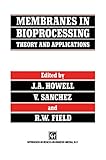Membranes in bioprocessing: theory and applications
Material type: TextLanguage: English Publication details: Glasgow: Spring-science+Business Media, 1993. Description: viii, 336p.; 22cmsISBN: 9789401049542Subject(s): Chemical engineering -- Membrane separation | Chemical engineering -- BiotechnologyDDC classification: 660.2842 H69
TextLanguage: English Publication details: Glasgow: Spring-science+Business Media, 1993. Description: viii, 336p.; 22cmsISBN: 9789401049542Subject(s): Chemical engineering -- Membrane separation | Chemical engineering -- BiotechnologyDDC classification: 660.2842 H69
| Item type | Current library | Collection | Call number | Status | Date due | Barcode |
|---|---|---|---|---|---|---|
 Reference
Reference
|
Dr. S. R. Ranganathan Library Reference | Reference | 660.2842 H69 (Browse shelf(Opens below)) | Not For Loan | 2261 |
Browsing Dr. S. R. Ranganathan Library shelves, Shelving location: Reference, Collection: Reference Close shelf browser (Hides shelf browser)

|

|

|

|

|

|

|
||
| 660.284 H68, 2:4 Chemical process principles: material & energy balances (part-1) | 660.2842 A88 Special topics in transport phenomena | 660.2842 G43, 4:9 Transport processes and separation process principles: (includes unit operations) | 660.2842 H69 Membranes in bioprocessing: theory and applications | 660.2842 M33, 7:35 Unit operations in chemical engineering | 660.2842 M33, 7:36 Unit operations in chemical engineering | 660.2842 N63 Membrane separations technology : principles and applications |
A. HOWELL School of Chemical Engineering, University of Bath, Clavertion Down, Bath, UK, BA2 7AY 1.1 WHAT IS A MEMBRANE PROCESS? Every day over 20 million liters of brackish water are pumped out of the ground near Jeddah in Saudi Arabia and passed through thin sheets of cellulose acetate known as reverse osmosis membranes before being used as part of the city's water supply. In St Maurice les Chateauneuf, France three million litres a day of ground water are ultrafiltered to supply the city and on test sites in Australia settled sewage is being disinfected by being passed through microfiltration membranes. Many of the foods we eat and beverages we drink have used membranes during their processing. Orange juice can be concentrated by membranes to make a concentrate which retains more of the flavour than does evaporation. Milk can be concentrated slightly by means of a membrane before making a cheese in a process which produces no whey. Gases rising from the ground in a waste tip can be piped away and the carbon dioxide separated from the methane by a membrane process allowing the methane then to be used as a fuel, simultaneously saving energy and reducing the greenhouse effect since methane is more effective as a greenhouse gas than carbon dioxide.
